THGThe illegal performance-enhancing drug
|
THGThe illegal performance-enhancing drug
|
No, THG is the acronym for tetrahydrogestrinone ((13S,17S)-13,17-diethyl-17-hydroxy-1,2,6,7,8,13,14,15,16,17-decahydrocyclopenta[a]phenanthren-3-one), or 13,20-diethyl-17-hydroxy-18,19-dinorpregna-4,9,11-trien-3-one or 18-homo-pregna-4,9,11-trien-17-ol-3-one, a steroid.

No, not an asteroid, a steroid - a molecule containing this ring system.
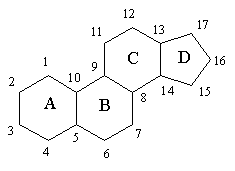
It was the anabolic androgenic steroid, also known as The Clear, used by BALCO (Bay Area Laboratory Co-Operative) to provide athletes with a steroid undetectable by doping controls.
To answer the second question first … Sportsmen, weightlifters to begin with, began to use steroids as performance enhancing drugs after World War II. They started with testosterone. This is the natural male sex hormone, which has anabolic effects, building tissue and muscle.
Yes. Testosterone was abused during the Cold War period, when America and the Iron Curtain countries used sporting success as a symbol of national pride. Athletes also took 17-esters of testosterone. The undecanoate ester of testosterone could be taken orally, otherwise injections or skin patches were used.
Testosterone gets broken down in the body (particularly to androstenedione) whether by oxidation of the (secondary) alcohol group at carbon-17 or by hydroxylation of the rings.
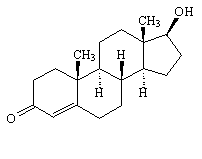
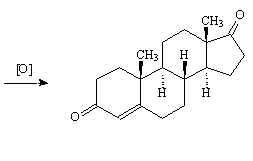
And excess levels of testosterone can be detected in drug tests. So scientists developed testosterone derivatives which were alkylated in the α-position at carbon-17, turning them into tertiary alcohols and making them harder to oxidise; also it became harder for enzymes to hydroxylate them, especially at carbons 10 and 16 ("avoiding liver first-pass metabolic degradation").
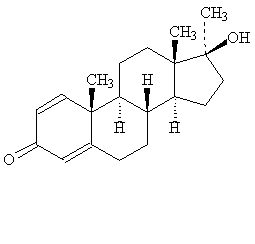
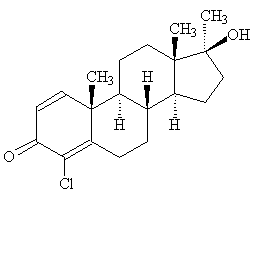
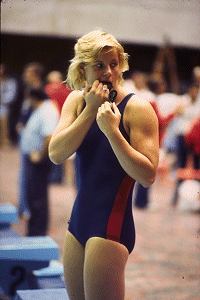 Dianabol (methandrostenalone) was released in 1958 as an anabolic steroid that did not interact with the androgen receptor, though it still produced androgenic (masculinising) effects. Long term use could result in serious liver damage. The next step was Turinabol, which was licenced for clinical use in 1965. Turinabol could be taken orally and had the advantage of being metabolised fairly quickly by the body (reducing the risk of detection). The potential for liver damage and other health complications remained. Turinabol was widely administered to East German athletes and swimmers, who were told that the blue pills they were given were vitamins or performance-enhancing chemicals. East German women swimmers took 11 out of 14 gold metals at the 1976 Montreal Olympics, but their androgenisation (broad shoulders and deep voices) did not pass unnoticed (see the photo of the East German swimmer Kornelia Ender from 1976, right). Sadly many of the teenage swimmers have encountered serious health problems later in life.
Dianabol (methandrostenalone) was released in 1958 as an anabolic steroid that did not interact with the androgen receptor, though it still produced androgenic (masculinising) effects. Long term use could result in serious liver damage. The next step was Turinabol, which was licenced for clinical use in 1965. Turinabol could be taken orally and had the advantage of being metabolised fairly quickly by the body (reducing the risk of detection). The potential for liver damage and other health complications remained. Turinabol was widely administered to East German athletes and swimmers, who were told that the blue pills they were given were vitamins or performance-enhancing chemicals. East German women swimmers took 11 out of 14 gold metals at the 1976 Montreal Olympics, but their androgenisation (broad shoulders and deep voices) did not pass unnoticed (see the photo of the East German swimmer Kornelia Ender from 1976, right). Sadly many of the teenage swimmers have encountered serious health problems later in life.
Other steroids abused by athletes included Stanozolol (found in urine samples taken from the Canadian athlete Ben Johnson at the 1988 Seoul Olympics), Furazabol and Nandrolone (MOTM October 2000).
|
Once established anabolic steroids like stanozolol became detectable, some athletes and coaches sought to stay ahead of the game. Patrick Arnold was a 1990 chemistry graduate; he was also a bodybuilder, a powerful combination. He delved deep into the older steroid literature and identified molecules that had already been synthesised and tested, but never marketed, so-called "designer steroids".
The three steroids associated with BALCO were Desoxymethyltestosterone (madol), norbolethone (both of which had been previously synthesised but never marketed) and tetrahydrogestinone, aka THG. THG was a totally new molecule. Norbolethone was originally known as "The Clear" as it was believed to be undetectable, since it had never been released onto the commercial market, and no one was on the look out for it. Norbolethone was identified in 2002 by Don Catlin, at that time the director of the UCLA Olympic Analytical Lab, in urine samples provided by the American cyclist Tammy Thomas.
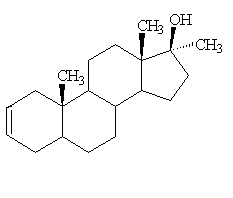
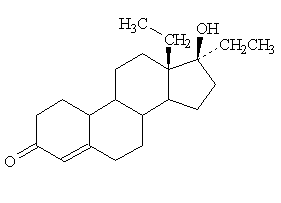
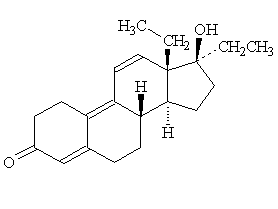
THG had never been made before, so it was even less likely to be detected than norbolethone.
Gestrinone was already known. It was developed originally [1974] as a possible oral contraceptive agent.

Catalytic hydrogenation of gestrinone is the obvious route to THG. Careful control of conditions is required to ensure that only the alkyne group is reduced. One published route uses a catalyst of palladium dispersed over finely divided carbon, operating at 0ºC to prevent reduction of the alkene groups, reaction being complete in a few minutes; alternatively, the activity of the catalyst can be reduced somewhat by "poisoning" with lead, and then the reaction takes 30 min or more at room temperature.
 It is not known how many sportsmen took THG. Don Catlin is reported to have examined some 20 urine samples that tested positive for THG. Athletes implicated included the British sprinter Dwain Chambers and a number of Americans, including the sprinter Kelli White and middle-distance runner Regina Jacobs. The most famous THG user is Marion Jones (photo, right), who won three gold medals and two bronze medals at the Sydney Olympics in 2000; in 2007, she admitted having used THG and was subsequently stripped of these medals by the International Olympic Committee (IOC) and the International Association of Athletics Federations (IAAF). The American baseball star Barry Bonds has also been linked with THG use but has consistently denied this (and has never failed any drugs test).
It is not known how many sportsmen took THG. Don Catlin is reported to have examined some 20 urine samples that tested positive for THG. Athletes implicated included the British sprinter Dwain Chambers and a number of Americans, including the sprinter Kelli White and middle-distance runner Regina Jacobs. The most famous THG user is Marion Jones (photo, right), who won three gold medals and two bronze medals at the Sydney Olympics in 2000; in 2007, she admitted having used THG and was subsequently stripped of these medals by the International Olympic Committee (IOC) and the International Association of Athletics Federations (IAAF). The American baseball star Barry Bonds has also been linked with THG use but has consistently denied this (and has never failed any drugs test).
In June 2003, an athletics coach contacted an official of the United States Anti-Doping Agency, saying that Victor Conte, head of BALCO, had been supplying leading athletes with drugs; the coach promised to send USADA a "used" syringe that had been thrown away at an athletics meeting. The anonymous coach was later revealed to be Trevor Graham, subsequently banned indefinitely by the US Olympic Committee from using their facilities.
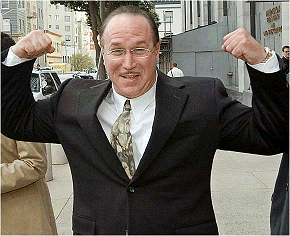 |
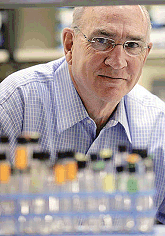 |
Victor Conte |
Don Catlin |
The contents of the syringe were passed to Don Catlin, who at that time was the director of the Olympic Analytical Laboratory at UCLA (University of California, Los Angeles) on June 13th 2003. His team of scientists followed the normal practice of converting it into the Me3Si derivative to enhance its volatility in the mass spectrum, but the resulting spectrum showed a large number of peaks defying identification. There was one clue, though, the presence of a small amount of norbolethone impurity, suggesting that norbolethone might have a similar skeleton to the unknown.
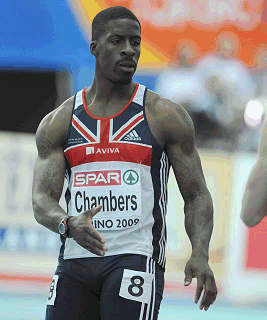 Comparison of the mass spectrum of the unknown steroid with known molecules showed considerable similarity with the spectrum of trenbolone and gestrinone below m/z = 211, indicating common structural features. The molecular ion in the mass spectrum of the unknown had m/z = 312; accurate mass determination gave 312.2080, leading to a most likely formula of C21H28O2. This led to the conclusion that the compound was 18-homo-pregna-4,9,11-trien-17-ol-3-one, so this compound was synthesised to confirm that the unknown had identical properties. A baboon was given very small amounts of THG; analysis of its urine confirmed that THG was excreted and could be detected in the urine, which could be used as the basis of a drugs test.
Comparison of the mass spectrum of the unknown steroid with known molecules showed considerable similarity with the spectrum of trenbolone and gestrinone below m/z = 211, indicating common structural features. The molecular ion in the mass spectrum of the unknown had m/z = 312; accurate mass determination gave 312.2080, leading to a most likely formula of C21H28O2. This led to the conclusion that the compound was 18-homo-pregna-4,9,11-trien-17-ol-3-one, so this compound was synthesised to confirm that the unknown had identical properties. A baboon was given very small amounts of THG; analysis of its urine confirmed that THG was excreted and could be detected in the urine, which could be used as the basis of a drugs test.
The laboratory went on to develop a test that could be used to establish whether a sportsman had taken THG, in time to identify it in samples taken from four athletes (Kevin Toth, Regina Jacobs, John McEwen and Melissa Price) at the U.S. National Championships in June that year. Dwain Chambers (photo, right), the European 100m champion, gave a positive test on a sample given on August 1st. Like the American sprinter Kelli White, he blamed Conte for supplying him with THG ("Victor explained it was a new product on the market that would aid me nutritionally"). White noted that, as well as affecting her menstrual cycle, THG gave her acne and changed her voice, not deeper but rasping.
Although some THG passes unchanged into the urine, one metabolic pathway involves an oxidative hydroxylation at carbon-18, followed by reaction of the hydroxy group with a glucuronic acid.
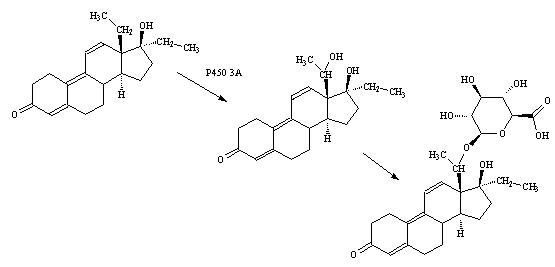
Analysis suggests that THG has very strong anabolic effects. This conclusion seems justified in view of the musculature of those taking it. It is also credited with considerable androgenic properties. A comparative study of binding of four potent androgens, the natural testosterone together with synthetic dihydrotestosterone, methyltrienolone and THG, showed that THG had the highest affinity for the human androgen receptor. The crystal structures of the human androgenic receptor with three of these, testosterone together with synthetic dihydrotestosterone and THG, revealed that THG makes more van der Waals' contacts with the receptor than do the other steroids, due to the presence of the 17-ethyl and 18-methyl groups, explaining why THG binds approximately twice as strongly to the human androgen receptor than does dihydrotestosterone.
In October 2005, Victor Conte was sentenced to four months in prison and another four on house-arrest, whilst in August 2006, Arnold was sentenced to three months in prison.
![]()
![]()